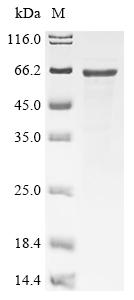Recombinant Mouse Neurofilament light polypeptide (Nefl) is produced using an E.coli expression system and covers the complete mature protein sequence from amino acids 2 to 543. The product comes without any tags, which should minimize potential interference in downstream experiments. Based on SDS-PAGE analysis, the protein purity exceeds 85%, though this level appears adequate for most research applications.
Neurofilament light polypeptide (Nefl) serves as a fundamental building block of the neuronal cytoskeleton. The protein seems particularly important for maintaining both structural integrity and proper diameter of axons - functions that are likely crucial for effective nerve impulse transmission. In neurobiology research, Nefl has become a protein of significant interest, especially when studying neuronal development, neurodegenerative diseases, and the mechanisms behind axonal transport.
Potential Applications
Note: The applications listed below are based on what we know about this protein's biological functions, published research, and experience from experts in the field. However, we haven't fully tested all of these applications ourselves yet. We'd recommend running some preliminary tests first to make sure they work for your specific research goals.
Nefl is a neuronal intermediate filament protein that requires proper folding and coiled-coil domain formation for its structural function in neurofilament assembly. While the absence of a tag reduces potential interference with folding, E. coli lacks the eukaryotic chaperones and post-translational modification machinery that may be important for the correct folding of complex structural proteins like Nefl. Without experimental validation (e.g., circular dichroism for secondary structure or filament assembly assays), the protein cannot be assumed to be correctly folded or bioactive. The high purity indicates low impurities, but does not guarantee native conformation.
1. Antibody Development and Validation Studies
The recombinant Nefl can serve as an immunogen for generating antibodies against linear epitopes. The full-length sequence provides comprehensive epitope coverage. However, antibodies generated may not recognize conformational epitopes important for neurofilament assembly. Validate antibody specificity against native neurofilaments from mouse neural tissue.
2. Protein-Protein Interaction Studies
Without a tag, interaction studies require alternative immobilization methods (e.g., chemical crosslinking). If Nefl is misfolded, interactions may be non-physiological. Validate any identified interactions using co-immunoprecipitation from neural tissue extracts or confirm with full-length Nefl from eukaryotic expression systems.
3. In Vitro Biochemical Characterization
Suitable for basic biophysical characterization (e.g., circular dichroism for α-helical content, dynamic light scattering for aggregation state). However, data may not fully reflect native Nefl properties if the protein is misfolded. The absence of post-translational modifications found in mammalian systems should be considered when interpreting results.
4. Cell-Free Assembly and Polymerization Studies
This application requires confirmed proper folding. Neurofilament assembly depends on correct coiled-coil domain formation. If Nefl is misfolded, it will not polymerize correctly. First, validate folding via circular dichroism, then test assembly using electron microscopy. The simplified in vitro environment may not fully replicate cellular assembly conditions.
Final Recommendation & Action Plan
Before using this recombinant Nefl for functional studies, validate its folding and assembly capability. Start with circular dichroism spectroscopy to confirm the expected α-helical content characteristic of intermediate filaments. Then test oligomerization state via size-exclusion chromatography with multi-angle light scattering (SEC-MALS). If properly folded, proceed with filament assembly studies by mixing with other neurofilament subunits and examining polymerization by electron microscopy. For antibody production, proceed but validate antibodies against native neurofilaments from mouse brain extracts. Always include appropriate controls with native neurofilament preparations when possible.






